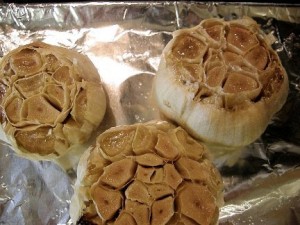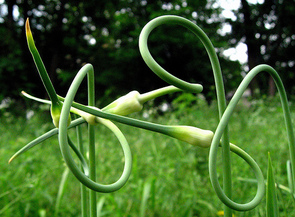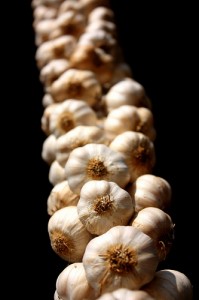Garlic is a gift to the world. The unwrapping of each clove endows more surprises than Christmases, birthdays, and strippers out of large cakes combined. Culinary speaking, a roasted clove endows a rich flavor to even the most paltry of dishes. Health-wise, ingesting even one raw clove a day adds powerful antioxidant weapons against the possible onslaught of cancer. In the garden, numerous bugs with greedy reputations will flee in droves at the mere mist of homemade garlic sprays. Farmers and hobbyists alike appreciate the green shoots of sprouting garlic amidst the glum whiteout of winter.

Right now is the season for garlic, both for the palate (thanks to an abundance at Farmer’s Markets) and the planter. In North Carolina, mid-September through the hard freeze (usually mid-November) is a great time to get garlic cloves in the ground.
Here’s a guide on which garlic will best suit your needs:
1) Garlic Varieties:
- Softneck (varieties include artichoke, common, and silverskin): Highly populous in supermarkets, softnecks grow well in most areas in North Carolina, have a delectable flavor, and store well for long periods. They are also the type of garlic you will see braided at many Farmer’s Markets. Their only shortcoming is its difficulty in peeling. Italian and New York varieties work well in the NC region, as well as kinds like the California Early and the Susanville.
*Note: The Creole varieties of softnecks will not do well in Western North Carolina due to its lack of cold hardiness and weak storage capabilities.
- Hardneck (including the German Extra Hardy and Music): More finicky than softnecks in this region, hardnecks can be difficult to grow and they don’t store well. Discouraged? Don’t be. Their attributes include easy peeling as well as developing scapes in their growing period. In the early spring, a round curled stem will grow out of the bulb. As it begins to straighten out, cut it off to stop the flowering process. This redirects the energy back into the bulb growth. Even better, the scapes can be used as a delicious addition to salads and stir fries.

The best hardneck varieties for the region include the German Extra Hardy (large bulbs which are excellent producers for both the home and commercial farmers), the Chesnok, and the Georgia Fire . For a challenge, try the Asiatic varieties. They are early producers, but you have to make sure to harvest them before their necks flop over (quite similar to onions). Still, the thought of having garlic in early spring…
- Elephant: I can’t be a full proponent of this giant leek posing as garlic. Plus, the flavor is incredibly mild. Still, they are great producers, and they can grow four times the size of a garlic bulb.
2) Garlic Seed Sources:
Unless you have an eye for garlic and know how to pick out select seeds from bought bulbs at Farmer’s Markets or (God forbid) supermarkets, you can purchase seed stock at:
Sow True Seeds in Asheville, NC or Virginia-based Southern Exposure Seed Exchange.
Also, check out Gourmet Garlic Gardens online. They are an indispensable resource for info as well as having links to countless farms around the country that offer unique varieties.
Next up: Get that garlic in the ground. Also, we discuss garlic’s best buddies in the soil: alfalfa and mycorrhizae.


Leave a Reply